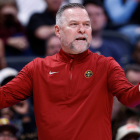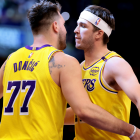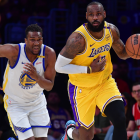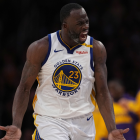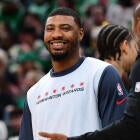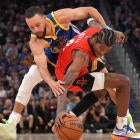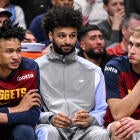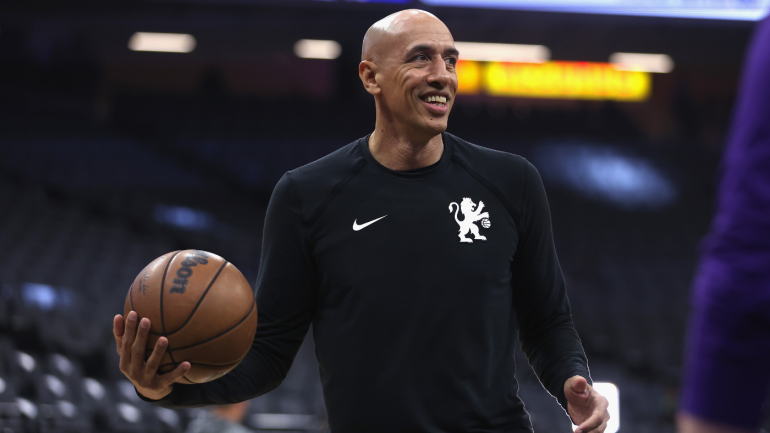
It took less than two minutes for Domantas Sabonis to make Doug Christie think about the old days. In February, on his first out-of-bounds play as a member of the Sacramento Kings, Sabonis caught a shovel pass from Justin Holiday at the high post, where the 7-footer palmed the ball and raised it above his head.
"I just went, 'Oh, shit,'" Christie said. "Because that's Webb, that's Vlade."
The play did not immediately honor the legacy of Chris Webber, Vlade Divac and the early-2000s Sacramento teams that started Christie on the wing, made coach Rick Adelman's corner offense sing and turned Arco Arena into a madhouse. Sabonis grabbed an offensive rebound, though, and again initiated his two-man game with Holiday, who had arrived in the same trade that brought him to Northern California. Sabonis waved the ball around in his left hand, then placed a pass perfectly to a cutting Holiday, who dumped it off to Chimezie Metu at the rim.
The players on the Kings' bench stood up and cheered when Metu threw down a two-handed dunk. Christie, an assistant coach, was already standing and applauding by the time he caught the ball.
Such moments didn't happen often last season, in which Sabonis played only 504 minutes in 15 games for Sacramento before the team shut him down with a knee injury. The offense was terrible overall and only average with Sabonis on the floor. "That team last year didn't understand how to cut," Christie said. But this year's Kings are learning. Under new coach Mike Brown, hired after six years as the lead assistant in Golden State, they have the fifth-best offense in the NBA a third of the way through the regular season, The only team that moves the ball more, per NBA CourtOptix, is the Warriors.
At the beginning of training camp, Brown preached five offensive staples: Pace, floor spacing, quick (i.e. 0.5-second) decisions, paint touches (i.e. strong drives, timely cuts, hard rolls) and ball reversals. "We want that thang going from side to side," Brown said, and they don't want the defense to get set and load up on De'Aaron Fox or Sabonis. No team in the league has been faster after a defensive rebound, per Inpredictable, and no team generates more points off of handoffs, per Synergy Sports.
Sacramento has been a happy early-season story because it hasn't made the playoffs in the 16 seasons since Adelman was on the sidelines, the longest such streak in North American professional sports. Along with the 15-12 record -- and the strong likelihood that the Kings will finally GET 40 WINS THIS YEAR! -- they have a style as striking as the purple beam that shoots skyward from atop Golden 1 Center after every victory. It's not the same as the style they had when Peja Stojakovic was lighting it up, but it's not that different, either.
If the 2001-2002 squad is Season 6 of "Game of Thrones," then the Beam Team is "House of the Dragon": Far from the height of the franchise's glory, but aesthetically pleasing and entertaining as hell. When Sabonis draws an extra defender near one corner and the Kings end up with an open 3 in the other, it is familiar. "The only way to get that is bang, bang, bang," Christie said, making a passing motion with his hands.
"That feel and that vibe is definitely there," Christie said.
Harrison Barnes was decidedly not rooting for Sacramento in the 2002 Western Conference finals, but he remembers.
"They were a complete team," Barnes said. "Even as a Kobe fan, I felt like they were the best team in the West. They had the shooting, they had the post-play, they had defenders. They had just a deep, deep team. I think they played the right way. It was fun basketball to watch."
Barnes sees parallels. "They were a high-octane offense, and we try to get out and run and do a lot of things similar," he said. But out of respect for the early-2000s teams, he stressed that they were "doing it at a higher level, with expectations, so I think that, while we try to emulate them, we have a lot of work to do on our end to get into that conversation."
If today's team is emulating yesterday's, most of the players are doing so unconsciously. The 30-year-old Barnes is the oldest player in the rotation. When Sports Illustrated put the Kings' starting five on the cover and dubbed them "The Greatest Show on Court," Kevin Huerter was two. Huerter didn't get to see that group in its heyday, and he hasn't watched much on YouTube, either.
"A little bit of Peja," he said. "Growing up, playing with Peja in 2K, I knew he could shoot. But that was really it."
When Christie's playing days come up now, it is not because he has decided to take a trip down memory lane and drag a bunch of 20somethings with him. "They just tell me how old I am and stuff like that," he said. "Which is totally cool." The spirit of those teams, though, is present every time he talks to them about making reads and improvisation.
"One thing with our teams is every movement was a chance for something to happen," Christie said. "It just wasn't a movement to move. And when you play that way, that means everything is live."
Christie knew his teammates would see him when he cut to the basket or slipped a screen. Adelman's playbook included a set called 4 Strong, in which Christie would catch the ball at the elbow and Stojakovic would come off a double screen from Webber and Divac. "Peja is the look, but so many times I would catch Vlade or Webb because his guy would help and they'd be right underneath the hoop and get a layup," he said. The present-day Kings run a play for a shooter to cut through the paint, then come off a corner pin-in, and, "the guy who screens him, a lot of times, is open," Christie said. But the screener hasn't been getting the ball.
Sabonis' supreme basketball IQ may have made it look like they're farther along than they really are. You can already see players cutting harder because they know there's a good chance he will find them. He and Huerter developed easy chemistry right away, and both Fox and Malik Monk have feasted on his dribble handoffs, too. As impressive as their offensive numbers are, there is still "so much" more room to grow, Christie said, to get to the point where they "see things happening before they happen" and all five players are moving in concert.
"Which is kind of crazy, right?" he said. "Which is mind-boggling. But as they continue to trust each other, listen to Coach, understand what we want, it's just going to continue to get better. And that's good for us because, as the playoffs come closer -- normally in the playoffs they take away option A, they usually take away option B -- that's where this type of offense can flourish. Because I'm looking at A, reading B; C and D might happen as well. And when we get to that point, well, we're cooking with grease."
Two and a half hours before tipoff at Madison Square Garden, Christie was on the court for Sabonis' pregame routine. He appeared to be having the time of his life. With two balls in his hands, he did a pirouette behind the 3-point line, then bounced one of them to Sabonis. After Sabonis' successful post-move, Christie did the "too small" gesture.
To Christie, this particular assistant coaching job is not like any other assistant coaching job. The press release that announced his hiring quoted him saying that he had dreamed of coaching for the Kings and felt he had "some unfinished business." He had reached basketball nirvana in Sacramento, and after the loss in 2002 and the eventual dissolution of the team, he wasn't done with the place. He was the team's color analyst for four years before joining the coaching staff, and he hosted a radio show on KHTK.
"When you get that close to something, it's something that sticks with you," Christie said. "So, I love to watch their success, I love to be what I would consider a very small piece of their success in the fact that I'm supporting them and working with them and talking to them."
Sacramento didn't win a title when it was the Greatest Show on Court, but it influenced teams that did. "Whether it's Golden State's style, the way that San Antonio was running the beautiful offense, white-hot in the playoffs -- a lot of the things, we did that," Christie said. "And now other people get credit for it. And that's OK. But that's where I want the Kings fans to get their respect." As good as he feels about where the team is going, he's just as excited about the fans he sees in Kings gear, holding their heads up high.
"They are turning out," Christie said. "The Golden 1 Center is beginning to define itself the same way that Arco Arena defined itself. And that's the special part."
To Christie, this support is inseparable from the Kings' passing, off-ball movement and speed. "Weirdly enough, it goes hand in hand," he said. "This is Sacramento Kings basketball." He wants to be able to close his eyes and envision their style of play as he walks to the court, and when he opens them, he wants what he sees to match. "That's how it was, and that's how it is. It's a style that is free-flowing, the people enjoy it. They enjoy the sharing. Is it a microcosm of our community? It just might well be." His former teammate Bobby Jackson is coaching the Stockton Kings, and "ultimately that's what we want to run down there in the G League as well."
Brown is the Kings' 11th coach since Adelman, and he's not the first of them to preside over a team that seemed to be on the right track. This is the first time, though, that they have conjured some of the magic that kept them a step ahead of the defense two decades ago. "As it defines itself more and more, it'll begin to be who we are," Christie said. "It's easy on the eyes. It's easy to play. You get smart players, players that understand how to play, and the rest takes care of itself." He said that Sacramento deserves that kind of team, and when he's watching one of those bang-bang-bang sequences on film, he notices more people at Golden 1 Center standing up with each pass. In those moments, there is a certain pride in the arena that is unmistakable.
"I can feel it," Christie said.
![[object Object] Logo](https://sportshub.cbsistatic.com/i/2020/04/22/e9ceb731-8b3f-4c60-98fe-090ab66a2997/screen-shot-2020-04-22-at-11-04-56-am.png)










